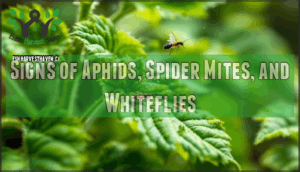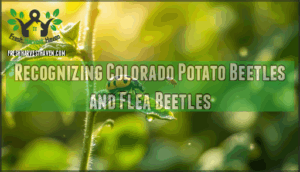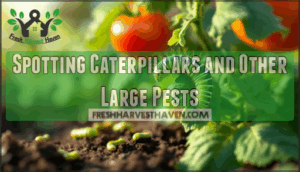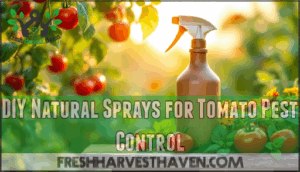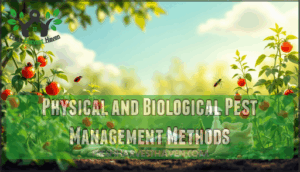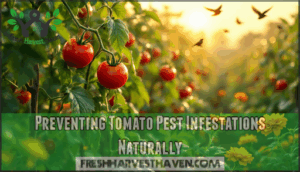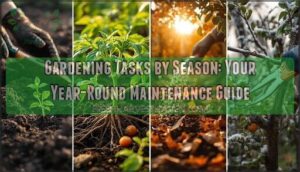This site is supported by our readers. We may earn a commission, at no cost to you, if you purchase through links.
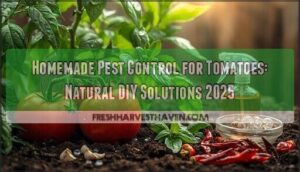
Chemical pesticides promise a quick fix, but protecting your tomatoes—and your soil—calls for something safer and smarter. Homemade pest control for tomatoes gives you the upper hand, letting you tackle garden troubles with ingredients from your pantry.
Empower your plants and your peace of mind with natural solutions that nurture your harvest from the roots up.
Table Of Contents
Key Takeaways
- Homemade pest control solutions use pantry ingredients like soap, garlic, hot pepper, and neem oil to effectively target common tomato pests—aphids, whiteflies, spider mites, beetles, and caterpillars—without chemical residues or environmental harm.
- Natural pest management delivers long-term cost savings ($100–$300 per acre annually versus $200–$600 for chemicals) while strengthening soil health, protecting beneficial insects, and commanding 20–65% higher market prices for organic produce.
- Physical control methods like handpicking, water sprays, sticky traps, companion planting with marigolds or basil, and introducing beneficial insects (ladybugs, lacewings, parasitic wasps) create a self-sustaining defense system when combined with homemade sprays.
- Prevention through garden hygiene, crop rotation, mulching, and regular monitoring (every 5–7 days) stops infestations before they escalate, reducing the need for intervention and building season-after-season resilience.
Common Tomato Pests and How to Identify Them
You can’t win the battle if you don’t know your enemy. Identifying tomato pests early gives you the upper hand in protecting your plants before damage spirals out of control.
Let’s walk through the most common culprits you’ll encounter and what to look for.
Signs of Aphids, Spider Mites, and Whiteflies
You’ll spot the first signs of these common sap-feeders on leaf undersides, where colonies gather to drain nutrients and leave behind telltale damage patterns. Watch for these infestation signs:
- Aphids cluster in green or black masses, secreting sticky honeydew that attracts ants
- Spider mites create fine webbing between leaves while their eggs appear as tiny white spheres
- Whiteflies flutter like miniature moths when disturbed, leaving yellowed, stippled foliage
Understanding pest life cycles helps you apply natural solutions before populations explode and damage becomes severe.
Recognizing Colorado Potato Beetles and Flea Beetles
While aphids and mites work undercover, two beetles announce their presence with bold stripes and acrobatic jumps that make them harder to miss—but no less destructive.
Colorado potato beetles display distinctive yellow-and-black longitudinal stripes across their rounded backs, feeding voraciously through multiple life stages. Flea beetles leave behind characteristic "shot-hole" damage—tiny circular perforations that riddle young tomato plants.
You’ll need careful pest inspection tips during your morning garden rounds to catch these beetles before populations surge beyond simple natural solutions and beetle control methods.
Spotting Caterpillars and Other Large Pests
Once beetles retreat from the spotlight, larger and often more conspicuous pests—caterpillars, hornworms, and cutworms—move in to strip foliage and sever stems with alarming efficiency. Tomato hornworms reach up to four inches long, bearing distinctive white V-shaped markings along their green bodies.
Caterpillar control begins with thorough pest inspection during garden monitoring sessions—check leaf undersides and soil surfaces at dawn. Large pest removal through handpicking remains your most effective natural pest control strategy, preventing extensive damage before homemade pest control sprays become necessary.
Benefits of Homemade Pest Control Solutions
Switching to homemade pest solutions gives you three key advantages over commercial pesticides. You’ll protect your health and the environment, save money throughout the growing season, and actually strengthen your garden’s ecosystem.
Let’s look at each benefit so you can see why natural control methods work better for your tomato plants.
Health and Environmental Advantages
When you skip synthetic pesticides, you’re not just protecting your family from chemical residues on tonight’s salad—you’re giving pollinators, soil microbes, and the entire backyard ecosystem a fighting chance to thrive.
Homemade pest control solutions promote organic gardening methods that won’t disrupt soil conservation or accelerate pest resistance. These eco-friendly, sustainable methods act as natural insecticides without compromising environmentally friendly gardening practices, making natural solutions for garden pests your smartest defense strategy.
Cost-Effectiveness Compared to Chemicals
You’ll often slash your initial costs to just $5–$30 per treatment with homemade pest control, while chemical pesticides demand $20–$50 upfront—and that’s before factoring in protective gear and disposal fees.
Long-term savings truly shine when you consider:
- Annual maintenance drops to $100–$300 per acre versus $200–$600 for chemicals
- Return on investment becomes positive within 2–3 growing seasons
- Organic produce commands 20–65% higher market prices
These DIY garden solutions deliver excellent cost efficiency without environmental remediation bills.
By adopting natural pest control methods, gardeners can reduce their reliance on chemical pesticides and create a more sustainable gardening practice.
Supporting Beneficial Insects and Soil Health
Resilience in your tomato patch starts underground and at wing’s edge. By embracing ecofriendly gardening, you’re boosting beneficial insects and soil microbes, key players in natural pest control. Companion planting, pollinator support, and natural fertilizers foster healthy, living soil. Together, these choices create a self-sustaining defense system for thriving tomatoes: Understanding tomato pest control is essential for a healthy harvest.
| Practice | Benefit | Example |
|---|---|---|
| Companion Planting | Attracts Beneficials | Marigolds |
| Pollinator Support | Improved Yield | Native Flowers |
| Natural Fertilizers | Soil Microbe Health | Compost Tea |
DIY Natural Sprays for Tomato Pest Control
Homemade sprays are a practical way to keep tomato pests in check. With a few basic ingredients, you can mix up effective solutions right in your kitchen.
Here’s what you need to know about making and using these natural sprays.
Soap and Oil Spray Recipes and Application
Ever wondered how simple soap and a splash of oil can outsmart bugs on your tomato plants? Mixing mild dish soap with water, or adding a bit of vegetable oil, creates an insecticidal soap that clings to aphids and mites without harming the plant.
Spray application targets pests directly, making soap recipes and oil sprays trustworthy natural deterrents in real-world pest control.
Garlic and Hot Pepper Spray Preparation
If the thought of bugs nibbling your tomatoes keeps you up at night, a homemade garlic or hot pepper spray might become your new secret weapon. These natural insect repellents utilize strong scents and spicy heat to keep pests at bay. Try these organic pesticides:
- Blend garlic cloves with water for a classic garlic repellent spray.
- Steep chopped hot pepper in water for hot pepper spray.
- Combine for potent homemade insecticidal sprays—simple, affordable pest deterrents.
Using Neem Oil and Essential Oils Effectively
Tired of tomato pests sticking around no matter what you try? Neem oil and essential oils might just be the gentle powerhouse your garden craves. Explore Neem Oil Benefits and Essential Oil Blends—rose, citrus, and lavender work wonders. With these oil spray recipes, you’ll have natural pest control methods that target bugs, but let your tomatoes—and your peace of mind—flourish.
| Pest Problem | Natural Insecticides | DIY Pest Control |
|---|---|---|
| Persistent aphids | Neem oil (smothers) | Easy spray recipes |
| Whitefly swarms | Lavender oil repellent | Gentle on you/soil |
| Mite trouble | Citrus oil blend | Boosts plant health |
Physical and Biological Pest Management Methods
After you’ve tried sprays and mixes, sometimes it takes a hands-on approach to stay ahead of tomato pests. There are a few practical tools and tactics you can use alongside natural solutions.
Here’s what you can do to protect your plants next.
Handpicking and Water Sprays for Immediate Control
There’s something surprisingly satisfying about rolling up your sleeves and taking care of tomato pests the old-fashioned way—one quick sweep with your hand or a burst from the hose can make all the difference. Handpicking keeps pest populations in check, while water sprays help dislodge aphids and mites.
This immediate action bolsters your overall garden hygiene and promotes healthy, resilient tomato plants.
Using Sticky Traps and Companion Planting
Sometimes, after you’ve picked off the obvious troublemakers, it helps to let simple tools like sticky traps and companion plants quietly work in your corner. Color matters with trap placement—yellow attracts many pests. Clever plant selection, like marigolds, aids nematode control. With companion planting, you’re not just fighting today’s invaders; you’re investing in long-term benefits for your tomato plants.
- Trap Placement: Position yellow sticky traps around tomato plants to catch whiteflies and other flying pests.
- Color Matters: Pests are particularly drawn to bright yellow, making these traps especially effective.
- Plant Selection: Incorporate marigolds or basil as companion plants for natural pest control solutions that deter nematodes and boost the health of your tomatoes.
Introducing Beneficial Insects and Applying Bt
Nature has its own team of assistants—ladybugs, green lacewings, lady beetles, and parasitic wasps—ready for a Beneficial Insect Release. They’re experts at tipping the scales of Pest Population Dynamics in your favor.
Stack the odds further with a timely Bt Spray Application. Integrated Pest Management, when you use biological pest control methods like these, means your tomatoes thrive naturally.
Preventing Tomato Pest Infestations Naturally
Keeping tomato pests at bay starts long before you spot the first bug. Simple, proactive steps build up your plant’s defenses and make your garden less welcoming to trouble.
Here’s what to focus on if you want your tomato patch to stay healthy all season.
Garden Hygiene and Crop Rotation Tips
With careful garden cleanup, you also remove last season’s pest hideouts but also give your organic gardening routine a real boost.
Rotating crops—switching tomatoes with celery, beans, or cabbage—breaks pest cycles and improves soil health.
Equipment disinfection and smart field management work hand in hand, strengthening your pest management strategies for a thriving vegetable garden.
Mulching and Soil Management for Pest Prevention
After tidying up last year’s mess and giving your soil a fresh start, laying down mulch and tending to the earth’s surface add another layer of protection that keeps trouble at bay. Here’s how:
- Regulate soil temperature
- Choose varied mulch types
- Suppress weeds
- Build organic matter
- Improve soil structure
These steps weave together gardening and pest control for strong tomato plant care.
Monitoring and Regular Maintenance Practices
Checking in on your tomato plants every few days quickly becomes second nature—and it’s the surest way to catch pests before they gain the upper hand. Routine crop inspection, soil testing, and regular pruning all support Tomato Plant Care.
Think of Pest Surveillance as a habit—woven with garden sanitation and ongoing vegetable garden maintenance. That’s the heart of sustainable pest management.
Frequently Asked Questions (FAQs)
What companion plants repel specific tomato pests?
Marigolds release compounds that provide nematode control, while basil’s repellent properties deter aphids and whiteflies. Garlic’s repellent and chive deterrents ward off flea beetles.
Companion planting for pest control with radish barriers traps root pests, creating natural pesticides for tomatoes through effective tomato plant pest management.
How often should homemade sprays be applied?
While constant vigilance seems necessary, excessive spraying actually harms plants.
Apply homemade bug spray like insecticidal soap or garlic spray every 5-7 days, adjusting reapplication rates based on pest monitoring and seasonal scheduling for best DIY garden solutions.
Can natural methods control severe pest outbreaks?
Natural methods work best for prevention and early detection through Integrated Pest Management, but severe pest outbreaks often need swift action.
Biological Pest Control like Bt and natural insect repellents for gardens can reduce populations markedly, though recovery takes time compared to synthetic options.
Which pests require immediate chemical intervention instead?
Like the fabled grasshopper who ate the ant’s winter stores, some pests cross the threshold where natural methods won’t suffice. High Risk Infestations of Armyworms, severe Hornworms outbreaks, or Toxic Pests like certain Aphids and Whiteflies colonies may require Emergency Interventions with targeted chemicals when populations exceed damage thresholds.
When natural defenses fail against severe armyworm, hornworm, or toxic aphid outbreaks, targeted chemical intervention becomes necessary to prevent catastrophic crop loss
How do weather conditions affect spray effectiveness?
Wind influence and temperature impact can drastically reduce spray efficacy.
Apply foliar sprays like neem oil, insecticidal soap, garlic spray, or dish soap spray during calm mornings when humidity effects improve weather resistance and coverage.
Conclusion
Your tomato plants—sentinels guarding fragrant vines and swelling fruit—deserve protection that honors their roots and yours. Homemade pest control for tomatoes transforms pantry staples into shields against invaders, keeping chemistry out and vitality in.
You’ve mastered identification, mixed sprays, planted companions, and built defenses layer by layer. Now watch aphids retreat, beetles surrender, and caterpillars vanish—not because you waged war, but because you cultivated balance.
Your harvest ripens clean, your soil thrives rich, and your garden stands resilient, season after season.

